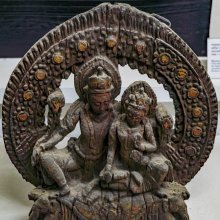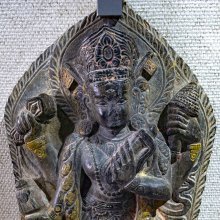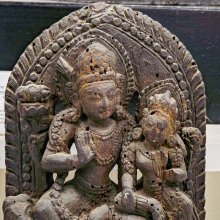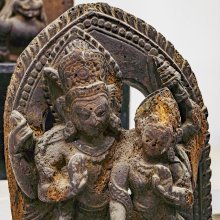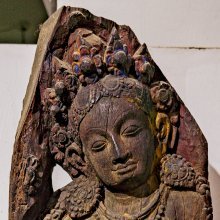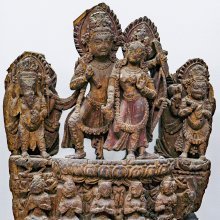Indrayani, Indrāyaṇī: 3 definitions
Introduction:
Indrayani means something in Buddhism, Pali, Hinduism, Sanskrit, biology. If you want to know the exact meaning, history, etymology or English translation of this term then check out the descriptions on this page. Add your comment or reference to a book if you want to contribute to this summary article.
Images (photo gallery)
(+1 more images available)
In Hinduism
Shaktism (Shakta philosophy)
Source: Wisdom Library: ŚāktismIndrāyaṇī (इन्द्रायणी) refers to the fourth of the eight Aṣṭamātṛkā (mother Goddesses) of Kathmandu city, locally known as Luti Ajimā. Her location is Indrāyaṇī near Dhalko (opposite Śobhā Bhagvatī).

Shakta (शाक्त, śākta) or Shaktism (śāktism) represents a tradition of Hinduism where the Goddess (Devi) is revered and worshipped. Shakta literature includes a range of scriptures, including various Agamas and Tantras, although its roots may be traced back to the Vedas.
In Buddhism
Tibetan Buddhism (Vajrayana or tantric Buddhism)
Source: OSU Press: Cakrasamvara SamadhiIndrāyaṇī (इन्द्रायणी) is the name of a deity [i.e., oṃ indrāyaṇyai svāhā], according to the Vāruṇī Pūjā [i.e., Varuni Worship] ritual often performed in combination with the Cakrasaṃvara Samādhi, which refers to the primary pūjā and sādhanā practice of Newah Mahāyāna-Vajrayāna Buddhists in Nepal.

Tibetan Buddhism includes schools such as Nyingma, Kadampa, Kagyu and Gelug. Their primary canon of literature is divided in two broad categories: The Kangyur, which consists of Buddha’s words, and the Tengyur, which includes commentaries from various sources. Esotericism and tantra techniques (vajrayāna) are collected indepently.
Biology (plants and animals)
Source: Google Books: CRC World Dictionary (Regional names)Indrayani in India is the name of a plant defined with Trichosanthes tricuspidata in various botanical sources. This page contains potential references in Ayurveda, modern medicine, and other folk traditions or local practices It has the synonym Modecca bracteata Lam. (among others).
Example references for further research on medicinal uses or toxicity (see latin names for full list):
· Hortus Suburbanus Calcuttensis (1845)
· Journal of Botany (1878)
· Encyclopédie Méthodique, Botanique (1797)
· Flora Indica (1832)
· Acta Phytotaxonomica Sinica (1974)
· Bijdragen tot de flora van Nederlandsch Indië (1826)
If you are looking for specific details regarding Indrayani, for example side effects, extract dosage, diet and recipes, chemical composition, health benefits, pregnancy safety, have a look at these references.

This sections includes definitions from the five kingdoms of living things: Animals, Plants, Fungi, Protists and Monera. It will include both the official binomial nomenclature (scientific names usually in Latin) as well as regional spellings and variants.
See also (Relevant definitions)
Query error!
Full-text: Ashtamatrika, Nirmasakalika, Nirmasa.
Relevant text
Search found 10 books and stories containing Indrayani, Indrāyaṇī; (plurals include: Indrayanis, Indrāyaṇīs). You can also click to the full overview containing English textual excerpts. Below are direct links for the most relevant articles:
Bhaktavijaya: Stories of Indian Saints (by Justin E. Abbott)
52.13: Tukaram’s mystic-mantra and Guru-lineage < [Chapter 52 - Tukaram (Continued)]
49.5: Tuka’s wife has her house plundered by the Brahmans < [Chapter 49 - Tukaram (Continued)]
46.16: Dnyandeva appears to Eknath in a dream < [Chapter 46 - Shri Khandya the Brahman]
Varahi Tantra (English Study) (by Roberta Pamio)
World Journal of Pharmaceutical Research
Effect of covid-19 < [2020: Volume 9, December issue 15]
Nanobots: Advancements and Applications in Medicine and Beyond < [2021: Volume 10, April issue 4]
Medicinal plant distribution in Arunachal's Kurung Kumey, East and West Kameng. < [2015: Volume 4, September issue 9]
Preceptors of Advaita (by T. M. P. Mahadevan)
(i) Jñānadeva < [56. Some Authors of Works in Regional Languages]
International Ayurvedic Medical Journal
Concepts of shiroabhyanga < [2022, Issue 5, May]
A case study- eka kushtha (psoriasis) treated with ayurvedic treatment < [2017, Issue IX, September]
Kathasaritsagara (cultural study) (by S. W. Chitale)
Description of Goddesses in the Kathasaritsagara < [Chapter 5 - Religion and Philosophy]
